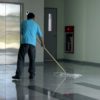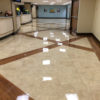Cleaning products are everywhere in our homes and offices: on dishes, countertops, furniture, clothes, floors, windows, and floating through the air. In our war on dirt and germs we may often actually be making things worse.
Most of the conventional cleaning products we all grew up with are petroleum-based and have dubious health and environmental implications. Instead of opting for cleaning products that annihilate everything in their path, there are plenty of natural products and methods that keep a house clean and fresh-smelling without the toxic side effects.
Top Green Cleaning Tips
Employ green cleaning products
As the health and environmental impacts of conventional cleaning products become more thoroughly understood, more and more brands of healthy, green, and effective cleaning products have started hitting the market and competing for that coveted place of honor under your sink. Many of these products are non-toxic, biodegradable, and made from renewable resources (not petroleum). But if designer labels aren’t for you, home-mixed cleaners can get the job done and then some. Vinegar and baking soda can be used to clean almost anything. Mix in a little warm water with either of these and you’ve got yourself an all-purpose cleaner.
Avoid poor indoor air quality
It is not uncommon for the air inside a home or office to be more toxic than the air outside. This is because of the presence of toxic materials and substances and the fact that homes and buildings are better insulated than ever before (which is a good thing from an energy standpoint). Keeping windows open as often as possible allows fresh air in and keeps toxins flowing out. This is especially important when cleaning your home.
Be careful with antibacterial cleaners
The antibacterial and antimicrobial ‘cleaners’ that many people think are necessary, especially during cold season, don’t clean hands better than soap and water, and also add to the risk of breeding “super germs,” bacteria that survive the chemical onslaught and have resistant offspring. The FDA has found that antibacterial soaps and hand cleansers do not work better than regular soap and water, and should be avoided.
Help your office smell baking soda-licious
Baking soda not only removes those strange smells coming from your fridge, it’s also a great odor-eliminator for your carpet. Just sprinkle on a little baking soda to soak up some of those odors and then vacuum it up.
Clean your indoor air naturally
Skip the store-bought air fresheners and instead try boiling cinnamon, cloves, or any other herbs you have a fondness for. Fresh chocolate chip cookies also have been known to create a friendly aroma. Also, plants may not make your house smell different but are good for filtering interior air–pretty much any broad green leaf plant will do. Peace Lilies are a favorite choice.
Toss toxic cleaners carefully
When replacing your cleaning products, don’t just throw the old ones in the trash. If they’re too toxic for your home, they won’t be good for the drain or the landfill either. Many communities hold toxics & electronics recycling days and will take all of these off your hands. Throwing chemicals in the trash or down the drain means they might end up back in your water supply and come back to haunt you.
Avoid conventional dry cleaners
Conventional dry cleaners are the largest users of the industrial solvent called Perchloroethylene, or perc, which is toxic to humans and also creates smog. The two most common green drycleaning methods are carbon dioxide cleaning and Green Earth. Seek out cleaners that use green methods. If you do take clothes to conventional cleaners, be sure to air them outside before wearing them or putting them in the closet.
Leave the toxins at the door
Imagine what’s on your shoes at the end of the day. Bringing that oil, antifreeze, animal waste, particulate pollution, pollen, and who knows what else into the house is not good news, especially for kids and other critters that spend time on floor level. Keep the sidewalk out of your home with a good doormat or a shoeless house policy. Many green buildings now include entryway track-off systems as a means of maintaining a healthy interior environment. Less dirt also means less sweeping, mopping, and vacuuming, which means less work, water, energy, and fewer chemicals.
Design with clean in mind
Designing houses and other building with cleanability in mind can create spaces that are cleaner, healthier, and require fewer substances to maintain. In larger buildings, good cleanability can also be a big money-saver as cleaning costs can often add up to as much as half of a building’s total energy costs.








